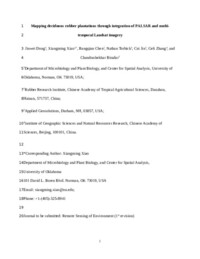Mapping deciduous rubber plantations through integration of PALSAR and multi-temporal Landsat imagery

Authors:
Due to increasing global demand for natural rubber products, rubber (Hevea brasiliensis) plantation expansion
has occurred in many regions where it was originally considered unsuitable. However, accurate maps
of rubber plantations are not available, which substantially constrain our understanding of the environmental
and socioeconomic impacts of rubber plantation expansion. In this study we developed a simple algorithm
for accurate mapping of rubber plantations in northern tropical regions, by combining a forest map derived
from microwave data and unique phenological characteristics of rubber trees observed from multitemporal
Landsat imagery. Phenology of rubber trees and natural evergreen forests in Hainan Island, China,
was evaluated using eighteen Landsat TM/ETM+ images between 2007 and 2012. Temporal profiles of the
Normalized Difference Vegetation Index (NDVI), Enhanced Vegetation Index (EVI), Land Surface Water
Index (LSWI), and near-infrared (NIR) reflectance for rubber trees and natural forest were constructed. The
results showed that rubber plantations are distinguishable from natural evergreen forests in two phenological
phases: 1) during the defoliation (leaf-off) phase in late February–March, vegetation index (NDVI, EVI,
LSWI) values were lower in rubber plantations than in natural evergreen forests; and 2) during the foliation
(new leaf emergence) phase in late March–April, rubber plantations had similar NDVI and LSWI values but
higher EVI and NIR reflectance values than in natural forests. Therefore, it is possible to delineate rubber plantations
within forested landscapes using one to two optical images acquired in the defoliation and/or foliation
period. The mapping technique was developed and applied in the Danzhou Region of Hainan. Phased Array
type L-band Synthetic Aperture Radar (PALSAR) 50-m Orthorectified Mosaic images were used to generate
a forest cover map and further integrated with the phenological information of rubber plantations extracted
from Landsat TM images during the foliation phase. The resultant map of rubber plantations has high accuracy
(both producer's and user's accuracy is 96%). This simple and integrated algorithm has the potential
to improve mapping of rubber plantations at the regional scale. This study also shows the value of time series
Landsat images and emphasizes imagery selection at appropriate phenological phase for land cover classification,
especially for delineating deciduous vegetation.
